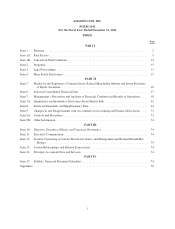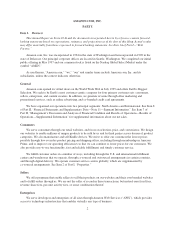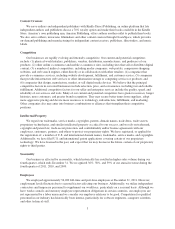Amazon.com 2011 Annual Report Download - page 19
Download and view the complete annual report
Please find page 19 of the 2011 Amazon.com annual report below. You can navigate through the pages in the report by either clicking on the pages listed below, or by using the keyword search tool below to find specific information within the annual report.have developed systems and processes that are designed to protect customer information and prevent data loss
and other security breaches, such measures cannot provide absolute security. In addition, we rely on third party
technology and systems in certain aspects of our businesses, including for encryption and authentication
technology to securely transmit confidential information.
We Face Risks Related to System Interruption and Lack of Redundancy
We experience occasional system interruptions and delays that make our websites and services unavailable
or slow to respond and prevent us from efficiently fulfilling orders or providing services to third parties, which
may reduce our net sales and the attractiveness of our products and services. If we are unable to continually add
software and hardware, effectively upgrade our systems and network infrastructure and take other steps to
improve the efficiency of our systems, it could cause system interruptions or delays and adversely affect our
operating results.
Our computer and communications systems and operations could be damaged or interrupted by fire, flood,
power loss, telecommunications failure, earthquakes, acts of war or terrorism, acts of God, computer viruses,
physical or electronic break-ins, and similar events or disruptions. Any of these events could cause system
interruption, delays, and loss of critical data, and could prevent us from accepting and fulfilling customer orders
and providing services, which could make our product and service offerings less attractive and subject us to
liability. Our systems are not fully redundant and our disaster recovery planning may not be sufficient. In
addition, we may have inadequate insurance coverage to compensate for any related losses. Any of these events
could damage our reputation and be expensive to remedy.
We Face Significant Inventory Risk
In addition to risks described elsewhere in this Item 1A relating to fulfillment center and inventory
optimization by us and third parties, we are exposed to significant inventory risks that may adversely affect our
operating results as a result of seasonality, new product launches, rapid changes in product cycles and pricing,
defective merchandise, changes in consumer demand and consumer spending patterns, changes in consumer
tastes with respect to our products and other factors. We endeavor to accurately predict these trends and avoid
overstocking or understocking products we manufacture and/or sell. Demand for products, however, can change
significantly between the time inventory or components are ordered and the date of sale. In addition, when we
begin selling or manufacturing a new product, it may be difficult to establish vendor relationships, determine
appropriate product or component selection, and accurately forecast demand. The acquisition of certain types of
inventory or components may require significant lead-time and prepayment and they may not be returnable. We
carry a broad selection and significant inventory levels of certain products, such as consumer electronics, and we
may be unable to sell products in sufficient quantities or during the relevant selling seasons. Any one of the
inventory risk factors set forth above may adversely affect our operating results.
We May Not Be Able to Adequately Protect Our Intellectual Property Rights or May Be Accused of
Infringing Intellectual Property Rights of Third Parties
We regard our trademarks, service marks, copyrights, patents, trade dress, trade secrets, proprietary
technology, and similar intellectual property as critical to our success, and we rely on trademark, copyright, and
patent law, trade secret protection, and confidentiality and/or license agreements with our employees, customers,
and others to protect our proprietary rights. Effective intellectual property protection may not be available in
every country in which our products and services are made available. We also may not be able to acquire or
maintain appropriate domain names in all countries in which we do business. Furthermore, regulations governing
domain names may not protect our trademarks and similar proprietary rights. We may be unable to prevent third
parties from acquiring domain names that are similar to, infringe upon, or diminish the value of our trademarks
and other proprietary rights.
11
























